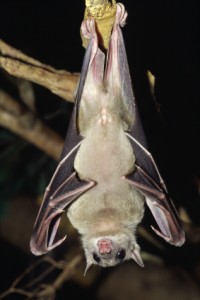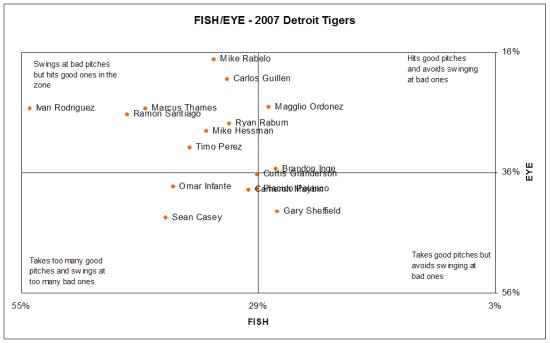I love looking at spray charts of batted balls and seeing where hitters have success. I’m funny like that. Fortunately Dan Fox, proprietor of his own blog and writer for Baseball Prospectus has released an application that shows ball in play distributions for the last 4 years and he just released the updated version including 2007 data. With the heavy lifting done for me, I thought I’d take a look at 3 of the Tigers more interesting hitters from the last year.
Brandon Inge
First up is the ever controversial Brandon Inge. Inge had an awful season at the plate as he posted a meager 236/312/376 line. Part of his problem was what seemed to be an endless supply of check swing strikeouts. And that appears to be the largest difference over the past few years. Inge’s batting average on balls in play was .334 which wasn’t out of line with his past performances. His batted ball distribution didn’t differ greatly from his fairly productive 2006 season.
|
BABIP |
GB |
FB |
LD |
PopUp |
| 2003 R |
0.262 |
44.8%
|
31.3%
|
17.9%
|
6%
|
| 2004 R |
0.344 |
42.6%
|
30.3%
|
19.4%
|
7.6%
|
| 2005 R |
0.333 |
39.5%
|
34.3%
|
18.7%
|
7.6%
|
| 2006 R |
0.324 |
39.9%
|
34.1%
|
15.1%
|
10.9%
|
| 2007 R |
0.334 |
37.9%
|
31.8%
|
20.6%
|
9.7%
|
Inge actually upped his line drive rate and had a small improvement in his pop up rate, yet his overall performance dipped. Maybe he was a little unlucky like he claimed earlier in the season?
Another complaint about Inge is that he became too pull happy.
|
Left |
Center |
Right |
| 2005 |
41.0 |
28.3 |
30.6 |
| 2006 |
48.1 |
27.0 |
24.8 |
| 2007 |
48.1 |
22.0 |
29.8 |
Inge did become more of a pull hitter in 2006 and it worked to his benefit as he slugged .463 and 27 balls left the park. He pulled just as much in 2007 but with a lot less success and a lot less power. We also saw Inge go to the opposite field more often, but it was at the expense of going up the middle. Based on observation and the data, it seems like it was more a function of Inge being late than looking to punch the ball to right.
Curtis Granderson
Nobody complained about Granderson pulling the ball too much, and he actually was more likely to pull the ball than Brandon Inge was. Of course, when you’re among the league leaders in extra base hits it doesn’t really matter where you hit the ball.
|
GB |
FB |
PU |
LD |
% |
| Left |
25 |
45 |
26 |
16 |
25.2% |
| Center |
25 |
57 |
4 |
19 |
23.6% |
| Right |
116 |
40 |
10 |
62 |
51.2% |
With Granderson’s proclivity for pulling the ball on the ground, it wouldn’t surprise me to see more teams shifting the shortstop closer to second base. I wouldn’t expect an Ortiz type shift because of Granderson’s speed and ability to bunt, but Curtis did hit .600 on grounders through the middle in 2007.
Magglio Ordonez
It seems that any look at Tigers performances isn’t complete without at least glancing at how Ordonez fared. It was a popular refrain from Rod Allen that Maggs was using the whole field, and it really was true. Ordonez hit 42% of his line drives to right field. And overall he hit the ball to right field as much as he hit it to left.
|
GB |
FB |
PU |
LD |
% |
| Left |
126 |
14 |
8 |
34 |
37% |
| Center |
32 |
51 |
4 |
30 |
24% |
| Right |
62 |
65 |
18 |
46 |
39% |
That kind of balance made it impossible for any team to load up one side. And in a spacious outfield like Comerica Park that gave Ordonez a lot of room to work with. Now granted he was still lucky in 2007. You don’t exceed career norms by that much without some things going your way. In the case of Ordonez it was a .318 batting average on ground balls and a .361 batting average on fly balls. MLB norms for the last 4 years were .233 and .272 respectively.
There’s a ton of information available, and it’s all free. So thanks to Dan Fox for his hard work, and let me know if you see anything interesting.
 With this afternoon’s loss to the Blue Jays the Tigers record in day games now stands at a remarkable 0-10. A quick check of the splits reveals that the Tigers have been outscored 57 to 18 in day games. Yes, the offense has mustered less than 2 runs a game before the sun sets.
With this afternoon’s loss to the Blue Jays the Tigers record in day games now stands at a remarkable 0-10. A quick check of the splits reveals that the Tigers have been outscored 57 to 18 in day games. Yes, the offense has mustered less than 2 runs a game before the sun sets.
